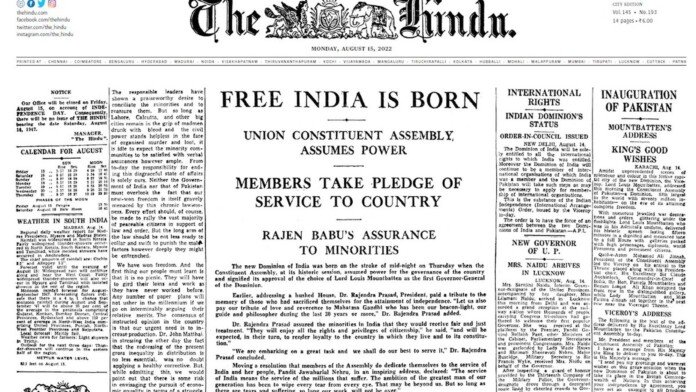By: Zahid Ahmed Tapadar
At the stroke of midnight on August 14, 1947, British colonial rulers transferred the administration of India. This historic moment of the declaration of independence and the attainment of freedom became memorable not only for Indians but for the entire world. This long-awaited declaration of independence filled every Indian heart with joy and pride. The moment of gaining independence at midnight marked the beginning of a new chapter in India’s history, establishing the country as a free and sovereign nation.
The news of liberation from two centuries of subjugation evoked deep emotions in India. Indians celebrated the dawn of a new era with pride, joy, and a sense of liberation, the result of long struggle and sacrifice. For countless people, the attainment of freedom was the beginning of a new era filled with hope for a better future. On the other hand, the reaction abroad, especially in Britain, was mixed. Some saw it as the end of an era in history, while others recognized independence as a justified and inevitable step. Globally, it was considered an important moment marking the decline of colonial rule and the rise of a new nation, which would transform the international political landscape.
The significance of this news was highlighted in both Indian and foreign newspapers. National and international media covered the celebration of independence with reports and editorials reflecting the joy, speeches by leaders, and concerns and aspirations for the future. Indian newspapers focused on the celebration of independence, the excitement, and the complexities associated with it, reminding citizens of their responsibilities. Meanwhile, foreign newspapers analyzed the social, cultural, and political contexts of the independence news and editorials.
Newspapers in various languages across India played a crucial role. They raised awareness and inspired unity among the people against the oppression, injustice, and exploitation of the British colonial rulers, motivating the public to support the anti-British movement. At that time, Indian newspapers became a major tool for awakening national consciousness, patriotism, and unity.
In the context of gaining independence, Indian newspapers reflected both the actual events and future concerns related to partition. They described the day of independence as a grand celebration. Various regional and linguistic newspapers published special editions for Independence Day.
In this article, we will focus on the coverage by Bengali and English newspapers. Major newspapers of India like The Times of India, Indian Express, The Hindu, Hindustan Times, Amrita Bazar Patrika, Anandabazar Patrika, and Jugantar had front-page coverage of Independence Day celebrations. Editorials highlighted the sacrifices of freedom fighters, the struggle of the people, and the beginning of a new era. Indian newspapers also reflected the diversity of public opinion across different regions and languages, expressing concerns about communal tensions and the partition of India and Pakistan.
Editorial columns in various newspapers across the country focused on the challenges of the future, the evils of division, economic restructuring, and the need for unity among different communities for a united and prosperous nation. Although editorials expressed positive views and optimism about the future, they also mentioned the harsh realities of building a new nation. The aspirations and realities of a newly independent nation were vividly depicted in these editorials.
Similarly, public opinion columns of Indian newspapers reflected the emotional reactions and responses of the people, focusing on democracy, social justice, and economic development. The role of leading figures such as Mahatma Gandhi, Jawaharlal Nehru, Sardar Vallabhbhai Patel, and Netaji Subhas Chandra Bose in the independence movement was extensively covered.
Indian newspapers, overwhelmed by the emotions of the Renaissance, described the day of independence as a moment of unprecedented joy and triumph. Celebrating the end of two centuries of foreign rule, these newspapers highlighted the strength and unity of the Indian people. They portrayed a nation that had, after many sacrifices and struggles, achieved long-desired freedom and self-determination.
We will now examine how the achievement of independence was reported in various Indian newspapers. The Jugantar newspaper of Bengal, published on August 15, 1947, had the headline: “Bharoter Shringkholmukti”. The main photograph featured Gandhi, with the caption: “Gana Parishad kortik Bharoter Swadhinota Ghosana”. Another newspaper of Bengal Anandabazar Patrika headlined on its front page with large letters: “Notun-Jug-Surjo Uthilo-Chutilo Timir Ratri”. The entire front page was covered with a map of the Indian subcontinent, featuring pictures of prominent leaders of the independence movement, including Rabindranath Tagore and Raja Ram Mohan Roy.
The Statesman wrote: “Two Nations are Born.” The Hindu’s headlines included: “Political Freedom for One-Fifth of the Human Race” and “The Beginning of a New Era.” The Indian Express’s headline read: “India Celebrates Freedom.” Hindustan Times headlined: “India Independent; British Rule Ends.” Similarly, Amrita Bazar Patrika wrote: “India Independent Today,” and The Times of India’s headline was: “Birth of India’s Freedom.” The Pioneer wrote: “Free India Cabinet Appeals: End Violence in Every Shape,” and The Tribune’s headline was: “India Wakes to Life and Freedom.”
National Herald and The Times of India published quotes from the historic speech given by the first Prime Minister Jawaharlal Nehru at midnight on August 14, 1947, in Parliament, where Nehru said: “Long years ago, we made a trust with destiny. Now the time has come when we shall redeem our pledge-not wholly or in full measure very substantially. At the stroke of the midnight hour, when the world sleeps, India will awake to life and freedom”.
The news of the transfer of power on August 14, 1947, was widely reported in major newspapers around the world, although their reports were influenced by their respective national interests and colonial biases. International newspapers expressed considerable curiosity about the achievement of independence and analyzed the impact of this freedom on global politics, with detailed reports often published on August 15.
Foreign newspapers discussed the end of British imperialism and its geopolitical implications in editorial articles. They highlighted the tragic and severe aspects of the partition of the country, such as migration, communal conflict, and humanitarian crises. Some foreign newspapers expressed cautious concerns about the potential of India as a democratic nation while discussing the challenges India would face in establishing a stable government, managing its diverse population, and building a strong economy.
Newspapers also depicted the experiences of struggle and hopes, aspirations, and dreams of the people. Essentially, foreign newspapers aimed to shed light on the complexities of independence, recognizing India’s achievement while noting the challenges and harsh realities that came with it.
For British newspapers, the achievement of independence was marked as the end of a mighty empire only. In contrast, American and European newspapers viewed independence as the emergence of the world’s largest democratic power, which would play a new role in international relations, trade, and diplomacy. Foreign newspapers also suggested that this independence might inspire other European colonial regions in Asia and Africa to seek self-determination.
From the New York Times of America to The Daily Telegraph of Britain, and in various countries around the world, major newspapers placed the topic of independence on their front pages.
On August 15, 1947, The New York Times featured a large map of the Indian subcontinent on its front page, with the headline: “Two Indian Nations Emerge on World Scene.” This American newspaper explained the celebration of long-awaited independence by 400 million people and the partition with the headline: “Death Toll in Communal Fighting Reaches 153.”
The Washington Post’s headline on the first page was: “India Achieves Sovereignty Amid Scenes of Wild Rejoicing.” This report mentioned how the celebrations of independence were marred by deaths and violence resulting from the partition.
The Manchester Guardian’s top news headline was “Farewell and Hail,” with a subheading: “End of the Indian Empire; Birth of Two Dominions.” It included a map of the Indian subcontinent marking the borders of India and Pakistan.
The Daily Telegraph’s headline read: “India is Now Two Dominions,” with a subheading: “Power Transferred at Midnight.” The newspaper’s front page featured a photo of the Union Jack at the Lucknow Residency, captioned: “Had never been lowered since recapturing of the town after the siege of 1857,” but noted that it was “hauled down for the first and last time at midnight.” The Daily Telegraph also featured a headline: “Indian Praises Britain.”
The Irish Times on August 15 had the headline: “India Celebrates as Britain Hands Over Control.” The Sun’s headline read: “India Attains Free Status as Two Dominions.” On the other hand, the headline of Morning News was: “Sovereign Pakistan and India Born.”
London’s famous The Times newspaper had only mentioned “Partition of India” in the ear panel of the front page. News about independence was printed on the fourth page, with the headline: “Power Handed Over in India,” and subheadings: “Birth of Two New Dominions” and “Lord Mountbatten on a Friendly Parting.” Additionally, the fourth page included special news on the communal violence in Punjab as a result of partition, with the headline: “High Death Toll in Punjab; Fierce Communal Battles.”
In summary, through various perspectives, both Indian and foreign newspapers provided a comprehensive picture of the momentous event of independence on August 15, 1947. While Indian newspapers focused on celebrating independence, national pride, and unity, foreign newspapers presented the achievement in a global context. Both domestic and international newspapers highlighted the historical significance and future challenges of independence. Together, these diverse viewpoints offer a rich and nuanced understanding of the long-awaited independence, which remains significant not only for India but for the entire world. (The author is an RO cum CHD, Information and Public Relations, BTC, Kokrajhar. He can be reached at 9401551455 or zahidtapadar@gmail.com)
















